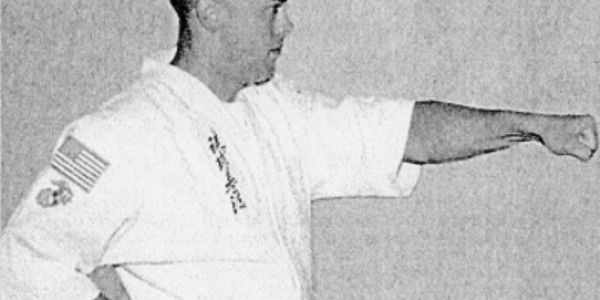
In this article a Medical Doctor Examines Karate-Do and Karate-Jutsu to find out which system has a better karate punch.
Much has been made of the philosophical differences between budo and bujutsu. Typically, these terms are translated as “martial way” and “martial science,” respectively. The martial ways are said to focus more on the development of moral character. This notion has been well-represented by Gichin Funakoshi, who wrote, “The ultimate goal of karate-do lies not in victory or defeat, but in the perfection of the character of the participant.” In contrast, the martial sciences are said to be primarily interested in the functional value of the art as a method of combat. This being a somewhat less-noble purpose, it is harder for the martial sciences to make a case for their continued existence. It is difficult to sell the parents of a 12-yearold on the claim that their child will learn the most effective fighting methods known. It is, however, quite an easy sell when the words “self-discipline,” “self-confidence” and “concentration” are bandied about. Often overlooked is that the unique philosophical perspectives of budo and bujutsu manifest themselves in differing technical elements. And nowhere is this more evident than in the basic punching techniques of karate-do and karate-jitsu.
Karate-Do Punch vs. Karate-Jutsu Punch
In karate-do, the punch begins with the fist on the hip and the palm facing up. The fist then drives forward to its ending point, centered in front of the body. As the punch extends, the fist rotates to a palm-down position. This is the full-twist punch that most people are familiar with. In karate-jutsu, the fist also begins on the hip with the palm facing tip. (It is important to note that there is less concern with the exact placement of the fist at the hip; therefore, it is sometimes angled slightly.) The fist drives forward, but it is not directly centered in front of the body. Rather, it is aimed slightly to the side just inside the line of the shoulder. Finally and most significantly, the fist turns only part way over, ending at roughly a 45-degree angle. That’s why it is generally called a three-quarter-twist punch. In keeping with the notion of practicality, karate-jutsu’s three-quarter twist- punch is strictly utilitarian. It is performed solely for purposes of combative effectiveness. One reason this is true, says Ralph Buschbacher, M.D., is that it is a more natural and structurally sound technique than the full-twist punch.
Buschbacher is uniquely qualified to discuss this topic. He holds the rank of seventh-degree black belt in Ryukyu kempo. He is also a clinical associate professor in the Department of Physical ‘Medicine and Rehabilitation at the Indiana University Medical Center in Indianapolis, Indiana, and has published numerous articles and authored or edited six medical textbooks. In 1992 he conducted cadaver studies to understand the physiology and mechanics of punching. He discovered that the anatomy of the forearm is specifically designed to handle stress in the exact manner of the three-quarter-twist punch.
Medical Evidence
The forearm has two bones: the thick radial bone and the thinner ulna. They are not straight but are curved so they can wrap around each other. That makes it possible for us to twist our hands from palm-up to palm-down. When punching a solid object, they are caught between the resistance of the target at the fist and the driving of the body at the elbow. As a result, they bend away from each other.
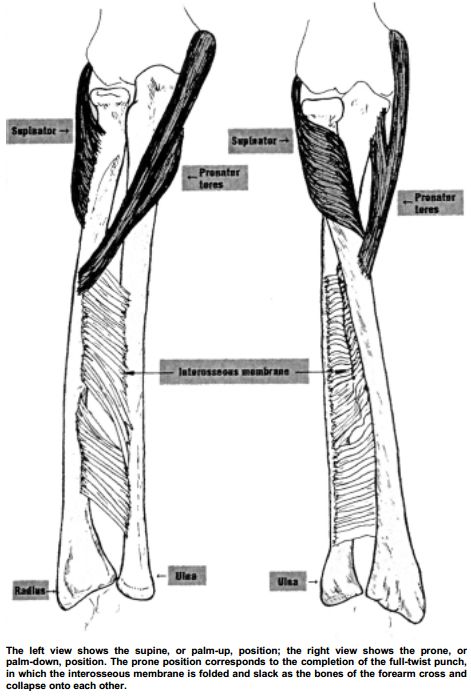 Because the ulna is thinner than the radius, it bends more readily and extremely, producing uneven support at the wrist. The body, however, compensates for this problem: Between the radius, and ulna is a thin but tough con nective tissue called the interosseous membrane. As the bones bow apartunder stress, the membrane is drawn I tight, transferring the stresses between the two bones to keep them from bowing further and maintain the structural integrity of the forearm. The force of the punch is distributed over the length of both bones so there is virtually no loss of power or injury.
Because the ulna is thinner than the radius, it bends more readily and extremely, producing uneven support at the wrist. The body, however, compensates for this problem: Between the radius, and ulna is a thin but tough con nective tissue called the interosseous membrane. As the bones bow apartunder stress, the membrane is drawn I tight, transferring the stresses between the two bones to keep them from bowing further and maintain the structural integrity of the forearm. The force of the punch is distributed over the length of both bones so there is virtually no loss of power or injury.
 However, what is even more impressive- and what Buschbacher’s research uncovered-is that the interosseous membrane does not transfer force laterally, but diagonally between the bones. The radius is quite thick near the wrist but thin near the elbow. The ulna, on the other hand, is thin at the wrist and thick near the elbow. The angle of the membrane ensures that the weaker portions of each bone attach to thicker portions of the other bone. And finally the angle of the membrane is designed to work with the natural stress alignments along the arm when a punch is delivered, it is typically force generated along the line of the radius. The pressure on the radius will cause it to move back slightly, but the angle of the membrane works to keep the bone in place and transfer the forces without any play or slack. (An implication of Buschbacher’s work is that care should be taken not to punch strongly with the middle, ring and pinky fingers because they direct the stress of the punch along the ulna. Buschbacher’s anatomical studies further demonstrated that during a full-twist punch, the ulna and radius wrap around each other-in essence, collapsing onto each other-and the connecting membrane is folded between them. With the membrane slack, it cannot support the structure of the forearm bones. Instead, they bend apart and shift on impact, producing unequal forces in the wrist and resulting in a loss of punching power and a risk of injury at the weakest points of the bones. Conversely, in the three-quarter-twist punch the position of the bones is such that optimal tension in the membrane is maintained throughout the movement.
However, what is even more impressive- and what Buschbacher’s research uncovered-is that the interosseous membrane does not transfer force laterally, but diagonally between the bones. The radius is quite thick near the wrist but thin near the elbow. The ulna, on the other hand, is thin at the wrist and thick near the elbow. The angle of the membrane ensures that the weaker portions of each bone attach to thicker portions of the other bone. And finally the angle of the membrane is designed to work with the natural stress alignments along the arm when a punch is delivered, it is typically force generated along the line of the radius. The pressure on the radius will cause it to move back slightly, but the angle of the membrane works to keep the bone in place and transfer the forces without any play or slack. (An implication of Buschbacher’s work is that care should be taken not to punch strongly with the middle, ring and pinky fingers because they direct the stress of the punch along the ulna. Buschbacher’s anatomical studies further demonstrated that during a full-twist punch, the ulna and radius wrap around each other-in essence, collapsing onto each other-and the connecting membrane is folded between them. With the membrane slack, it cannot support the structure of the forearm bones. Instead, they bend apart and shift on impact, producing unequal forces in the wrist and resulting in a loss of punching power and a risk of injury at the weakest points of the bones. Conversely, in the three-quarter-twist punch the position of the bones is such that optimal tension in the membrane is maintained throughout the movement.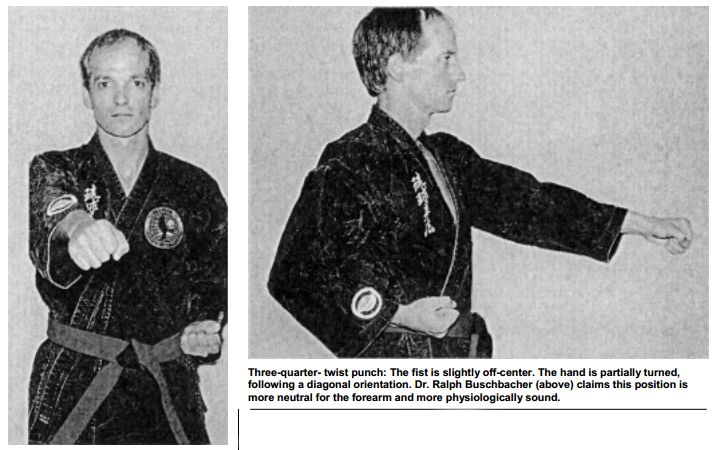
Muscle Power
The muscles of the forearm are also important when punching. The ones that turn the forearm into the palm-up position are called supinator muscles. Those that turn the palm down are called pronator muscles. They oppose each other. If the fist is turned fully palm-up, the supinators are completely contracted and the pronators are completely stretched. Like-wise, when the palm is turned down, the pronators are fully contracted and the supinators fully stretched. In the three quarter-twist position, the pronators and supinators are equalized, each being approximately in the middle of its respective range of motion. The result is muscular balance that contributes to the overall stability of the forearm. In contrast, at the conclusion of the full-twist punch, the supinators are fully stretched and unable to balance the contraction of the pronators. Since these muscle groups help support the wrist, their unbalanced state increases the likelihood of the fist buckling on impact.
Firsthand Proof
The other notable difference, between the karate-do punch and the karate-jutsu punch is their final position. As mentioned earlier, the karate-do punch lines up with the center of the body, while the karate-jutsu punch is aligned just inside the shoulder. The reason for the karate-jutsu alignment is skeletal mechanics. However, rather than trying to describe this in detail, one need only perform a simple test.
Ask a skilled karateka (karate practitioner) to strike a makiwara (punching board). While he punches, observe the alignment of his fist and shoulder with respect to the makiwara. Regardless of how lie was taught to punch, when lie is actually pounding on the makiwara, he will automatically line up the fist and shoulder. It is impossible to strongly punch the board so that the fist is lined up with the center of the body. Quite simply, the off-centered alignment of the karatejutsu punch is physiologically natural and the karate-do method of aligning the fist with the centerline is not.
Clearly, from the perspective of human structural mechanics, the three-quarter-twist punch is better for hitting hard. Its ideal skeletal and muscular alignment means that more energy can be transferred to the target with less likelihood of injury. But another feature of the punch is that it hurts more to get hit with it. The reason is that the human body is not made up of vertical and horizontal lines; it is made of angles and curves. The angled fist at the completion of the three-quarter-twist punch fits the contours of the body in such it way that it is simply more effective.
“Most martial artists twist their hand to a full palm-down position when punching,” Buschbacher says. “This weakens the force dissipation from the radius to the ulna by the interosseous membrane of the forearm. An alternative 45-degree angle [threequarter turn punch] is recommended instead. It creates a better alignment of the bones and interosseous membrane; however, many martial artists will be reluctant to make this change.”
One reason they might be reluctant to change is that the full-twist punch is so common that they assume it is the traditional method. But clearly the three-quarter-twist method is more practical, more in keeping with the oldest traditions of karate. So it is not surprising that evidence from the most traditional styles suggests that the full-twist punch is not the original method and that the three-quarter-twist punch is.
Back to the Source
Matsumura seito shorin ryu, the style descended from Hohan Soken, uses a three-quarter-twist punch, as does the shorin-ryu lineage of Chotoku Kyan and the Ryukyu kempo style taught by Seiyu Oyata. The vertical-fist punch of isshin-ryu, the style developed by Tatsuo Shimabuku, is in fact a three-quarter-twist punch. All these styles are old-fashioned karate. Their methods are closer to-if not the same as-the original karate that was developed in Okinawa. That raises the question: If the three-quarter-twist punch is original, where did the full-twist punch come from?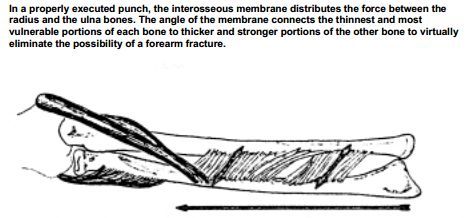
A karate instructor of the matsumura seito shorin-ryu style related the following story: A group of black belts was training with an Okinawan master. As they performed their punching techniques, some used a full-twist punch. The master berated them: “That punch is for hitting your friends. This [three-quarter-twist punch] is for hurting.”
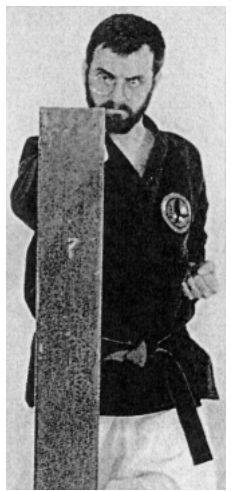 In the matsumura orthodox system, the full-twist punch is taught to the low ranks and the three-quarter-twist punch is taught to the black belts. So apparently the full-twist punch is one that beginners may use without undo fear that they will injure each other. Later, when their control and technique have improved, they learn the punch they can use to defend themselves. A similar observation can be made of Oyata’s teaching method: Beginners learn a full-twist punch, and the three-quarter-twist punch is described as “advanced.” That may provide a clue to how and why the full-twist punch developed.
In the matsumura orthodox system, the full-twist punch is taught to the low ranks and the three-quarter-twist punch is taught to the black belts. So apparently the full-twist punch is one that beginners may use without undo fear that they will injure each other. Later, when their control and technique have improved, they learn the punch they can use to defend themselves. A similar observation can be made of Oyata’s teaching method: Beginners learn a full-twist punch, and the three-quarter-twist punch is described as “advanced.” That may provide a clue to how and why the full-twist punch developed.
Some researchers believe that the full-twist punch was developed with safety in mind. At the turn of the 20th century, Anko Itosu modified karatejutsu into karate-do so he could teach it to schoolchildren. To make a fighting art that has as its motto ikken hisatsu (to kill with one blow) suitable for children, Itosu had to tone down the dangerous techniques. It is interesting to note that Itosu is credited with developing the full-twist punch, and it is even more telling to note that he apparently intended that a threequarter- twist punch was to be used in actual combat.
Apparently, Itosu developed and taught the full-twist punch to create a safer environment in which to train young people, giving instructors time to instill morality and respect. That alone would justify the use of the fulltwist punch in many settings. But there is another reason for its existence:
aesthetics.
Philosophically speaking, karate-do is about the development of character. All arts in the Okinawan/Japanese tradition that are regarded as do (wav) have a strong sense of aesthetics as a means for developing character. Rituals, forms and prescribed actions of simple beauty are an essential component.
In martial arts that follow the do tradition, part of this aesthetic expression lies in the use of horizontal and vertical lines. Interestingly, a general characteristic of the jutsu (science or skill) approach to the martial arts is the predominance of diagonal lines. For example, in iaido the sword is most likely to be drawn to execute a horizontal cut followed by a vertical downward cut. In battojutsu, the draw-cut is more likely to be a diagonal upward slice, followed by a diagonal downward blow.
Likewise, in karate-do the knifehand strike is performed in a beautiful horizontal movement, as if a teacup has been placed on the palm. But in karate-jutsu, the same technique is done on a downward angle that matches the direction necessary for hitting the pressure points of the neck. Similarly, the full-twist punch of karate-do seeks elegant horizontal and vertical lines; while the three-quartertwist punch of karate-jutsu keeps to the diagonals, appearing almost casual and unfinished.
In addition to considerations of safety and aesthetics, there is one more quality found in the full-twist punch: exercise. While executing it, the forearm muscles are fully stretched and fully contracted sequentially, as described above. In the threequarter- twist punch, the forearm muscles only work to the point of greatest structural equilibrium. This means that the full-twist punch moves the forearm muscles through a greater range of motion than the three-quarter-twist punch.
Likewise, the alignment of the punch in the center of the body increases the range of motion of the chest and shoulder muscles. The pectoral muscle is more fully contracted and the lateral deltoid is more completely stretched with the karate-do method. As a result, the centered, fulltwist punch is a better form of calisthenics than the off-centered, three-quarter-twist version.
(Having said this, a word of caution is in order. While a centered, full-twist punch may be better exercise, the three-quarter-twist punch is structurally superior for actual striking. Therefore, those who practice the full-twist punch should use only this method when performing kata (forms) or drills, but never when punching the makiwara or heavy bag to minimize the risk of injury.)
Final Question
Each method of punching has advantages. The question you must answer is, Which is the more important consideration? If your main reason for training is non-utilitarian (health. discipline, exercise, etc.), the full-twist punch may be more appropriate. If however, it is functionality (self-defense), you should follow the doctor’s advice: The three-quarter-twist punch is the only choice.

